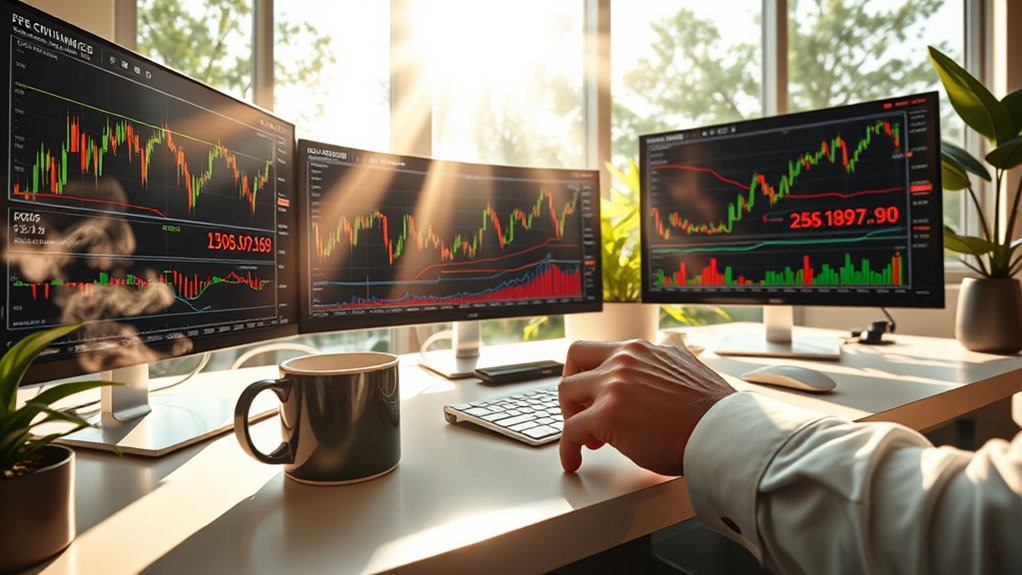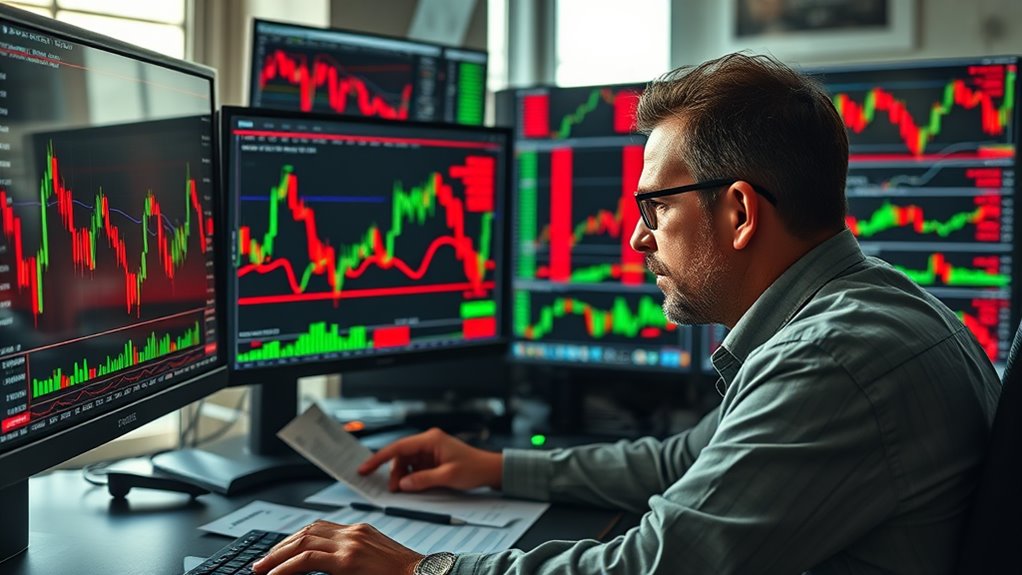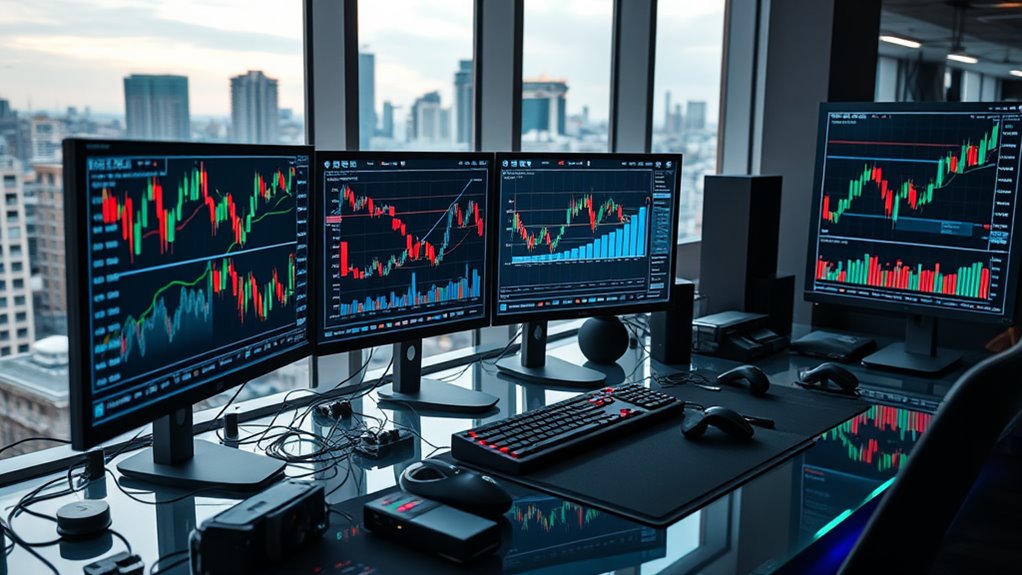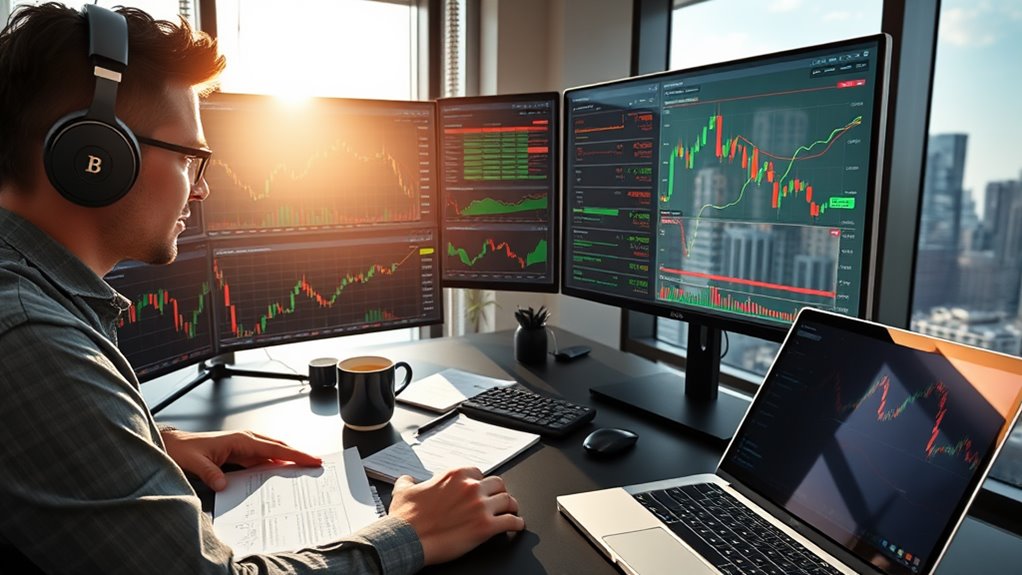
Day Trading Strategies in Crypto: What You Need to Know
Day trading in cryptocurrencies involves leveraging market volatility and liquidity, mastering technical analysis tools like RSI and MACD, and applying robust risk management strategies, including stop-loss and take-profit orders. Traders use various strategies such as momentum trading and scalping to capitalize on price movements influenced by market sentiment and news. Choosing the right trading platform enhances strategy effectiveness. For strategic success, understanding these elements is key, paving the way for more in-depth exploration of profitable opportunities.
Key Takeaways
- Utilize technical analysis tools like RSI and MACD to determine optimal entry and exit points.
- Monitor market sentiment and news, as they heavily influence price fluctuations.
- Implement stop-loss and take-profit orders to manage risks and secure profits effectively.
- Explore diverse strategies like scalping, momentum trading, and range trading to exploit market dynamics.
- Constantly adapt to regulatory changes and their impacts on market conditions and trading strategies.
Understanding Market Volatility and Liquidity

Market volatility and liquidity are two pivotal factors that greatly shape the trading landscape in cryptocurrency markets.
High volatility in crypto markets stems mainly from regulatory uncertainties, rapid changes in market sentiment influenced by news and social media, and considerable supply and demand imbalances. This volatility can attract traders looking for high gains but also increases the risk considerably.
High volatility in crypto markets often leads to significant trading risks and opportunities.
On the other hand, liquidity, which is generally lower in crypto markets compared to traditional markets, affects how quickly and efficiently assets can be bought or sold without causing drastic price changes.
High liquidity in major cryptocurrencies like Bitcoin and Ethereum provides somewhat smoother and safer trading experiences but can still succumb to sharp volatility due to considerable trading actions by large holders known as "whales."
A beginner's guide to these markets should always incorporate the principles of risk management, focusing on tools and strategies to mitigate potential losses amidst these unpredictable conditions.
Mastering Technical Analysis Tools

Mastering technical analysis tools is vital for traders aiming to navigate the fluctuating landscapes of the cryptocurrency markets effectively. Indicators like the Ichimoku Cloud and Bollinger Bands provide insights into market trends and volatility, essential for making informed trading decisions. Understanding chart patterns, such as Head and Shoulders or Triangle Patterns, helps traders predict potential market movements. For short-term trading, tools like the RSI and MACD are indispensable for identifying ideal entry and exit points by analyzing momentum and market sentiment. Additionally, using sophisticated software such as TradeStation or MetaStock enables the integration of these various tools, enhancing the ability to develop, test, and apply thorough trading strategies effectively. A fundamental understanding of blockchain technology plays a crucial role in grasping the underlying mechanics influencing cryptocurrency values and market dynamics.
Implementing Risk Management Techniques

In the domain of crypto day trading, setting effective stop-loss orders is vital for managing potential losses and safeguarding investments from sudden market downturns. Traders also need to establish clear risk-reward ratios to define the expected returns on each trade relative to the risk undertaken. These techniques, fundamental for controlling exposure and maximizing profitability, must be applied consistently to guarantee long-term success in the volatile cryptocurrency markets. Additionally, employing emotional discipline is crucial to avoid making impulsive trading decisions that can lead to significant financial losses.
Setting Stop-Loss Orders
Many traders adopt stop-loss orders as a strategic tool in cryptocurrency trading to cap potential losses and reinforce the discipline of their investment decisions. These orders are pivotal in managing risks, allowing traders to set a predetermined price at which their positions automatically sell. This mechanism helps avoid larger losses during market downturns, especially important in the volatile crypto environment. By setting stop-loss orders, whether full, partial, or trailing, traders can define their risk tolerance clearly. Additionally, these orders facilitate emotion-free trading by ensuring decisions aren't influenced by sudden market movements or emotional biases. Despite potential complications like slippage or premature triggering due to market volatility, strategic placement helps maximize their effectiveness. Moreover, understanding the psychological aspects of trading is crucial when setting these orders, as maintaining a solid mindset(knowledge) ensures consistency and rational decision-making in volatile markets.
Determining Risk-Reward Ratios
Calculating risk-reward ratios is essential for cryptocurrency traders evaluating potential trades. This ratio, balancing potential gains against losses, is pivotal in volatile markets.
Traders employ these ratios, typically structured as 1:2 or 1:3, to decide if a trade's possible profits justify the risks under the current market conditions. A dynamic application of risk-reward ratios enables traders to adapt their strategies according to shifting market dynamics and personal risk tolerance.
By utilizing these ratios, traders can manage potential downfalls more effectively, leading to more calculated and informed decision-making in a field known for rapid and significant price fluctuations.
Ultimately, this contributes to enhanced trading outcomes by maintaining a balanced approach to risk and reward.
Additionally, understanding margin trading principles can significantly refine a trader's use of risk-reward ratios by incorporating leverage effects into their strategic calculations.
Exploring Different Day Trading Strategies

Although the cryptocurrency market teems with various trading strategies, understanding the distinct methods can greatly enhance a trader's efficacy.
Momentum trading captures profits from strong price moves, typically driven by fresh news or significant trading volume, requiring traders to act fast as trends sustain momentum.
Range trading, on the other hand, is suited for markets that fluctuate within a defined span, where traders buy at support levels and sell at resistance.
Scalping involves making numerous trades to garner small profits, highly dependent on swift execution.
Arbitrage traders benefit from price discrepancies across different exchanges, needing rapid responses to be effective.
To optimize these strategies, traders heavily rely on real-time data and technical tools such as MACD and RSI.
For those looking to delve deeper, platforms highlighted in the review offer security features that ensure safety besides enhancing trading efficiency.
Impact of Market Sentiment and News

The influence of market sentiment and news on cryptocurrency day trading cannot be overstated, as traders engage in evaluating sentimental shifts that often dictate the pace of buying and selling.
News-triggered price fluctuations, particularly those stemming from regulatory updates or statements by influential figures, play a pivotal role in shaping the trajectory of cryptocurrency prices.
Additionally, tweets and other social media posts by key industry players can lead to immediate and significant market responses, essential for traders to monitor and respond to swiftly.
Identifying trading volumes is crucial as spikes in volume can validate the significance of a price move, indicating stronger market interest and potential continuity in direction.
Evaluating Sentimental Drifts
Why does sentiment in the market shift, and what impact can this have on day trading?
Market sentiment in cryptocurrency trading encompasses the general feeling or mood of traders toward a specific asset and can shift due to a variety of factors including market news and social media trends.
This shifting sentiment impacts day trading greatly as it can profoundly influence crypto prices, sometimes even overpowering technical indicators.
Day traders must monitor these sentimental drifts closely, using tools like sentiment analysis on social media and the Fear & Greed Index to detect sudden changes.
Spotting these shifts early can allow traders to capitalize on momentum plays or prepare for potential reversals, making sentiment analysis an essential component of effective day trading strategies.
A new sentence with emotional regulation plays a crucial role in managing the impacts of these shifts, as understanding and controlling emotions can lead to more rational decision-making in volatile markets.
News-triggered Price Fluctuations
How do market sentiments and news releases trigger fluctuations in the prices of cryptocurrencies?
Major announcements about regulatory changes often lead to significant price swings, as uncertainty or stability is forecasted. When large corporations adopt cryptocurrencies, prices usually surge due to increased legitimacy and anticipated demand.
Conversely, negative events like exchange hacks can prompt swift sell-offs, plummeting values. Economic shifts, such as variations in interest rates by central banks, can also affect cryptocurrency attractiveness, altering investment actions.
Additionally, coordinated statements from financial authorities might provoke preemptive reactions among investors, further intensifying price volatility.
These dynamics underscore how sensitively cryptocurrency markets respond to news and shifts in economic indicators, making them highly reactive to external factors. This reactivity highlights the delicate balance regulators strive to achieve between promoting market stability and fostering innovation in this evolving sector.
Influential Tweets Impact
Influential tweets frequently drive rapid changes in cryptocurrency market sentiment, demonstrating the potent intersection of social media and financial markets.
When notable figures like Elon Musk tweet, they can instantaneously affect prices by shifting sentiment. This dynamic often leads to significant price movements as traders react to the emotional tones of tweets, creating spikes in buying or selling activity based on fear or greed.
Such impacts, primarily short-term, necessitate adaptability in trading strategies. By integrating tweet sentiment analysis with tools like the Fear & Greed Index, traders can more accurately gauge market moods and manage risk, leveraging these swift shifts for potential profit in the highly volatile crypto markets.
Furthermore, as regulatory clarity continues to evolve, the responsiveness of the market to influential tweets might change, potentially moderating the extreme impacts seen from such social media interactions.
Utilizing Trading Bots and Automation

Utilizing trading bots and automation has become a cornerstone of modern crypto trading strategies. These bots operate 24/7, executing trades based on predefined criteria and signaling systems, such as TradingView.
They can be customized with specific strategies like Dollar Cost Averaging and Grid Trading, ensuring adaptability to different market conditions. Their ability to integrate with multiple exchanges enhances their versatility.
Additionally, these tools offer significant advantages by handling simultaneous trades across diverse cryptocurrencies, thereby aiding in risk management and maintaining trading consistency.
Explore how trading bots enhance portfolios by managing multiple cryptocurrency trades, boosting risk management and trading consistency.
For ideal use, traders should select appropriate strategies, configure bots carefully, and consistently review their performance to adjust parameters, ensuring that the bots' activity aligns with current market trends and trading goals.
The Role of Stop-Loss and Take-Profit Orders

As a trader enters the complex world of crypto markets, the use of stop-loss and take-profit orders remains essential in managing potential risks and securing earnings. These tools provide an automated method to close trades, either limiting losses or locking in profits based on specific market conditions.
Key aspects of these orders include:
- Automation: Allows for setting predefined exit points for both losing and winning trades, executing decisions without emotional interference.
- Risk Management: Enhances the trader's ability to preserve capital by preventing substantial losses and protecting gains.
- Flexibility: Offers the capability to adjust or cancel orders in response to changing market dynamics, providing adaptability across various trading scenarios.
Identifying Optimal Trade Entry and Exit Points

While identifying ideal trade entry and exit points is essential for successful day trading in the cryptocurrency market, it involves a systematic analysis of various technical indicators and patterns.
Traders often use moving average crossovers to recognize trend changes, signaling prospective entry moments when a short-term average crosses above a long-term average. For exits, a crossover in the opposite direction might suggest a selling opportunity.
Tools such as RSI and MACD indicators help determine overbought or oversold conditions, suggesting entry or exit timings in alignment with possible price reversals.
Additionally, understanding candlestick patterns and monitoring volume can enhance decision-making, ensuring entries and exits are based on solid market signals, thereby optimizing trade effectiveness and profitability.
Incorporating Macro and Microeconomic Factors

In the sphere of day trading cryptocurrencies, understanding global economic indicators is essential as they dictate broader market conditions that influence crypto valuations.
The impact of regulatory changes must also be assessed, as they can drastically alter market dynamics and investor behavior within the crypto space.
In addition, the effects of corporate adoption play a significant role in crypto price movements by either legitimizing the asset in the eyes of traditional investors or enhancing its utility.
Global Economic Indicators
Understanding Global Economic Indicators is pivotal when delving into day trading strategies in the cryptocurrency market. These indicators provide insights into overall economic health and potential impacts on crypto asset values.
Key indicators include:
- GDP and Employment Reports: Indicative of economic strength, these reports can sway investor confidence and influence crypto trading volumes and prices.
- Inflation Rates: As inflation increases, cryptocurrencies may be viewed as alternative investments, potentially boosting their demand and value.
- Monetary Policies: Decisions on interest rates and fiscal policies can alter market sentiment, affecting investment strategies across cryptocurrency platforms.
Day traders must analyze these indicators to predict market trends, ensuring informed and strategic trading decisions in the volatile crypto market.
Regulatory Impact Analysis
After examining how global economic indicators influence cryptocurrency trading, it is equally important to contemplate the role of regulatory frameworks.
Global inconsistencies in regulatory climates alter trading strategies, as countries like El Salvador embrace cryptocurrencies, while others impose strict bans. This disparity necessitates adaptation, leading to volatility when changes occur.
Governments employ AML and KYC policies, enforcing transparency but also increasing compliance burdens, disproportionately impacting smaller traders. Proactive awareness of impending regulations can offer strategic advantages to traders, facilitating timely portfolio adjustments.
Nonetheless, maneuvering through this complex milieu can divert resources from trading efficiency, highlighting the necessity of monitoring regulatory trends to mitigate risks and capitalize on potential opportunities.
Corporate Adoption Effects
Several corporations are recognizing the potential of Bitcoin and other cryptocurrencies, thereby substantially impacting both macroeconomic environments and their own microeconomic operations.
As companies integrate these digital assets into their financial strategies, they contribute to market dynamics in several ways:
- Market Influence: Corporate investments can drastically affect Bitcoin's market price due to their sizable cash flows.
- Operational Advancements: Cryptocurrencies improve transactional efficiencies and expand potential customer demographics globally.
- Strategic Benefits: Early adopters in the corporate sphere might gain a competitive edge, preparing for a future dominated by digital currencies and diversified financial landscapes.
These factors underscore the pivotal role of corporate adoption in shaping the economic and strategic contours of the cryptocurrency market.
Selecting the Right Trading Platforms and Tools

Selecting the right trading platforms and tools is essential for any aspiring day trader in the cryptocurrency markets, as it can greatly influence trading effectiveness and efficiency.
For those prioritizing low fees and high liquidity, Binance offers a thorough solution with a vast array of cryptocurrencies.
Beginners might favor Coinbase for its educational content and support of multiple blockchains.
Active traders seeking leverage might find Bybit suitable when combined with its user-friendly interface.
Consider Pionex for automated trading strategies due to its range of automated tools and competitive fees.
Prioritize security features; platforms like Kraken and Crypto.com are renowned for robust security protocols, thereby ensuring a safer trading environment.
Frequently Asked Questions
How Does Daylight Saving Time Affect Crypto Trading Hours?
Daylight Saving Time affects crypto trading by causing shifts in market hours as platforms adjust their server times to align with traditional financial markets, leading to potential volatility and liquidity fluctuations.
Can Weather Events Influence Cryptocurrency Market Trends?
Weather events can affect cryptocurrency trends by influencing mining profitability and operational costs. Extreme conditions may alter energy prices, impacting network stability and trader sentiment, leading to price fluctuations and potential trading opportunities.
What Are the Tax Implications of Crypto Day Trading?
Crypto day trading triggers several tax implications, including capital gains tax on profits and complex reporting needs due to frequent trades. Utilization of tax software and professional advice is essential for compliance.
How Do Cryptocurrency Forks Impact Day Trading Strategies?
Cryptocurrency forks stir the market like a spoon in a cosmic coffee cup, altering volatility. Day traders must adapt strategies rapidly to handle new uncertainties and opportunities presented by these unforeseen splits in blockchain paths.
What Role Does Network Congestion Play in Trade Execution Times?
Network congestion greatly impacts trade execution times by causing delays. High transaction volumes and limited network capacity result in slower order processing, potentially affecting trade outcomes and contributing to market inefficiency.
Conclusion
Maneuvering the volatile waters of cryptocurrency day trading demands a well-equipped toolkit. By mastering technical analysis, implementing sturdy risk management practices, and understanding market sentiment, traders can more securely sail towards profitable shores. Selecting the right platforms and tools, alongside timely entry and exit, serves as the compass guiding these endeavors. Such strategic armory empowers traders to not only survive but thrive in the tempestuous sea of crypto trading.












